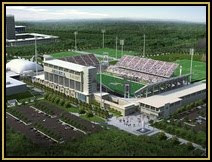.jpg) Lee McElroy’s e-mail inbox and voicemail system are clogged every day with questions about the stadium complex he wants to build at the University of Albany.
Lee McElroy’s e-mail inbox and voicemail system are clogged every day with questions about the stadium complex he wants to build at the University of Albany.
“It’s complicated,” says McElroy, the school’s athletics director.
That’s an understatement in the ongoing recession. McElroy is rewriting his department’s business model as he contends with the state’s multi-billion-dollar deficits, which threaten to delay progress on the prized sports complex.
UAlbany has asked McElroy to cut spending in his $13 million budget by up to 10 percent. At the same time, as much as 10 percent of the school’s donors and sponsors—including auto dealers—have cut back or eliminated their contributions amid the sour economy.
It’s a situation filled with nuances that illustrate the challenges McElroy faces as he tries to build his fundraising department.
“We can cut and cut and cut, but we must generate more revenue and income. We really have to rethink how we go about that,” McElroy said.
‘Not there yet with donor base’
McElroy risks undercutting his own program, depending on how he responds to the fiscal pressures.
He joined the school in 2000, one year after UAlbany made the jump to Division I athletics, the highest level of competition in the National Collegiate Athletic Association.
Donations have soared in the past two years, spurred by back-to-back conference championships and NCAA Tournament appearances by the men’s basketball team.
McElroy credits that national exposure for exciting new and existing donors. Yet travel is the department’s third-largest expense, and McElroy intends to decrease the out-of-state trips that the school’s 19 teams take next school year to save money.
“Our coaches are focusing on regional competition now,” McElroy said. “But that could have an impact on recruiting and fundraising. In what other event can Albany compare to schools like Stanford?”
UAlbany athletics did not need many donors before it moved up to Division I competition because most funding came from the school or the state, said Don Ostrom, the school’s director of athletic development. He is half of the school’s two-person athletics fundraising operation.
Today, state funding and student fees supply almost half of the department’s budget, which supports 70 full-time employees. The majority of the budget—as much as 60 percent—comes from ticket and merchandise sales, sponsorships, advertising and donations.
Ostrom, who visits with 15 to 20 donors a month, wants to build an endowment so the department can decrease its reliance on fundraising. The economy has delayed those plans.
“The vast majority of donations that come in during a fiscal year are being spent in that same fiscal year. We need those dollars to operate today,” Ostrom said.
“When you’re only in your 10th year of competing at a Division I level, we’re just not there yet with our donor base,” he added. “And unfortunately, we need to get there sooner than later.”
Positive signs exist. UAlbany has sold all its sponsorships for a men’s basketball conference tournament it’s hosting in March—a “miraculous” feat, McElroy said.
Still, the economy has led some donors to spread out their contributions over the year, as opposed to writing one check. Others have skipped their annual donation.
‘still pushing’
This year, state legislators could decide that they, too, lack the funds to support McElroy’s proposed sports complex. If so, that would delay the project, McElroy said.
The centerpiece of the sports complex is a new stadium that would cost between $40 million and $50 million, holding as many as 15,000 fans. That would at least double both the athletic department’s budget and its seating capacity for football games.
McElroy’s sales pitch rests on economic development.
“This stadium is not just for UAlbany athletics. That’s part of it, but it’s more for the economic development and promotion of the Capital Region,” McElroy said. “It’s an investment in the future.”
Adds Daniel Nolan, a key donor: “This could have a positive economic impact for decades.”
McElroy will be asking for millions of dollars at a time when legislators must erase $15.4 billion of red ink over the next 15 months. Funding for the complex was dropped from last year’s state budget in last-minute negotiations.
UAlbany has paid $300,000 for a site study that should be finished by the end of next month. The study will recommend various designs and locations for the new complex.
McElroy said he needs at least $20 million from the state to make the complex feasible.
“The state’s investment will drive the design,” he said.
Private donations for the project, which McElroy has been securing for nearly two years, would have to supply most of the remaining funds.
“It would be pretty tough, unless Albany has some sugar daddies ready to step up. And even if they do, it’s a bigger step up for them now than it was six months ago, with the economy,” said Bruce Johnson, a sports economics professor and stadium expert at Centre College in Kentucky.
Nolan, a 1974 alumnus, said he’s not as concerned that the economy will dent so-called “major gifts” that are tens or hundreds of thousands of dollars in size.
“We’re still early into this [economic] crisis. But, I’ve never seen an economy where it’s so bad that people just stop giving. The economy will scare people, but it won’t scare them down to zero,” said Nolan, managing director of Johnson Illington Advisors LLC, an Albany financial firm.
McElroy hopes that’s the case, even as he and his donors deal with fewer resources.
“We aren’t slacking,” he said. “It’s a perilous time, but we still have to act and lead. We’re still pushing.”
asichko@bizjournals.com | 518-640-6818
Friday, January 16, 2009
University of Albany Athletics Needs Donors To Step Up Now To Support Stadium Fund
Posted by
BRE
at
6:52 AM
![]()
Labels: Football Stadium, UAlbany sports, University of Albany
Subscribe to:
Post Comments (Atom)

.jpg)




.jpg)
+(2).jpg)
.jpg)
.jpg)

.jpg)
+(2).jpg)
+(2).jpg)
+(2).jpg)
_(2)+(2).jpg)
+(2).jpg)
+(2).jpg)
_(2)+(2).jpg)
+(2).jpg)


.jpg)
.jpg)
+(2).png)
+(2).jpg)
.jpg)
.jpg)
+(2).jpg)
+(2).jpg)
+(2).jpg)
.jpg)
+(2).jpg)
+(2).jpg)
+(2).jpg)
_(2)+(2).jpg)
+(2).jpg)
.jpg)
+(2).jpg)
+(2).jpg)
+(2).jpg)
.jpg)
.jpg)
+(2).png)
.jpg)
.jpg)
.jpg)
.jpg)
+(2).jpg)
+(2).jpg)

.jpg)

+(2).jpg)
.jpg)
.jpg)
.jpg)
.jpg)
.jpg)
.jpg)
.jpg)
.jpg)
.jpg)
.jpg)
.jpg)
.jpg)
.jpg)
.jpg)
.jpg)
.png)
.png)
.jpg)
.jpg)
.jpg)
.jpg)
.jpg)
.jpg)
+(2).jpg)
.jpg)
+(2).jpg)
.jpg)
+(2).jpg)
.jpg)
.jpg)
.jpg)
.jpg)
.jpg)
.jpg)
.jpg)
.jpg)
.jpg)
.jpg)
.jpg)
.jpg)
.jpg)
.jpg)
.jpg)
.jpg)
.jpg)
.jpg)
.jpg)
.jpg)
.jpg)
.jpg)
.jpg)
.jpg)
.jpg)
.jpg)
.jpg)
.jpg)
.jpg)
.jpg)
.jpg)
.jpg)
.jpg)
.jpg)




No comments:
Post a Comment